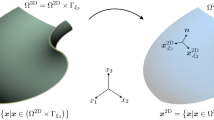Abstract
This work concerns finite-element algorithms for imposing frictional contact constraints on intra-element, or embedded surfaces. Existing techniques typically rely on the underlying bulk mesh to implicitly partition the surface, a strategy that can give rise to overconstraint. In the present work, we first apply a mortaring algorithm to the modeling of frictional contact conditions on arbitrary interfaces. The algorithm is based upon a projection of the bulk and surface fields onto independent mortar fields at the interface. We examine the advantages of this approach when combined with extended finite-element approximations to the bulk fields. In particular, the method allows for bulk and surface domains to be partitioned separately, as well as enforce nonlinear contact constraints on surfaces that are not explicitly “fitted” to the bulk mesh. Results from several benchmark problems in frictional contact are provided to demonstrate the accuracy and efficacy of the method, as well as the improvement in robustness compared to existing techniques. We also provide an example that illustrates the effectiveness of the approach in high-speed machining simulation.
Similar content being viewed by others
References
Armero F, Garikipati K (1996) An analysis of strong discontinuities in multiplicative finite strain plasticity and their relation with the numerical simulation of strain localization in solids. Int J Solids Struct 33:2863–2885
Belgacem FB, Hild P, Laborde P (1991) Approximation of the unilateral contact problem by the mortar finite element method. Comptes Rendus De L’Academie Des Sciences 324:123–127
Belytschko T, Black T (1999) Elastic crack growth in finite elements with minimal remeshing. Int J Numer Methods Eng 45(5):601–620
Bernardi C, Maday Y, Patera AT (1992). A new nonconforming approach to domain decomposition: the mortar element method. In: Brezia H., Jll JL. (ed). Nonlinear partial differential equations and their applications. Pitman and Wiley, London, pp. 13–51
Daux C, Moës N, Dolbow J, Sukumar N, Belytschko T (2000) Arbitrary branched and intersecting cracks with the extended finite element method. Int J Numer Methods Eng 48:1741–1760
Dolbow J (1999) An extended finite element method with discontinuous enrichment for applied mechanics. PhD thesis, Northwestern University
Dolbow JE, Devan A (2004) Enrichment of enhanced assumed strain approximations for representing strong discontinuities : addressing volumetric incompressibility and the discontinuous patch test. Int J Numer Methods Eng 59(1):47–67
Dolbow JE, Moës N, Belytschko T (2001) An extended finite element method for modeling crack growth with frictional contact. Comput Methods Appl Mech Eng 190:6825–6846
Duarte CA, Hamzeh ON, Liska TJ (2001) A generalized finite element method for the simulation of three-dimensional dynamic crack propagation. Comput Methods Appl Mech Eng 190:2227–2262
Hansbo A, Hansbo P (2002) An unfitted finite element method, based on nitsche’s method, for elliptic interface problems. Comput Methods Appl Mech Eng 191:5537–5552
Ji H, Dolbow J (2004) On strategies for enforcing interfacial constraints and evaluating jump conditions with the extended finite element method. Int J Numer Methods Eng 61:2508–2535
McDevitt TW, Laursen TA (2000) A mortar-finite element formulation for frictional contact problems. Int J Numer Methods Eng 48(10):1525–1547
Moës N, Belytschko T (2002) Extended finite element method for cohesive crack growth. Eng Fracture Mech 69(7):813–833
Moës N, Dolbow J, Belytschko T (1999) A finite element method for crack growth without remeshing. Int J Numer Methods Eng 46:131–150
Mourad HM, Dolbow J, Garikipati K (2005) An assumed-gradient finite element method for the level-set equation. Int J Numer Methods Eng 64:1009–1032
Papanastasiou TC (1987) Flow of materials with yield. J Rheol 31:385–404
Simone A (2003) Continuous–discontinuous modelling of failure. PhD thesis, Technische Universiteit Delft
Strenkowski JS, Moon KJ (1990) Finite element prediction of chip geometry and tool/workpiece temperature distribution in orthogonal metal cutting. J Eng Ind 112:313–318
Author information
Authors and Affiliations
Corresponding author
Rights and permissions
About this article
Cite this article
Kim, T.Y., Dolbow, J. & Laursen, T. A mortared finite element method for frictional contact on arbitrary interfaces. Comput Mech 39, 223–235 (2007). https://doi.org/10.1007/s00466-005-0019-4
Received:
Accepted:
Published:
Issue Date:
DOI: https://doi.org/10.1007/s00466-005-0019-4




